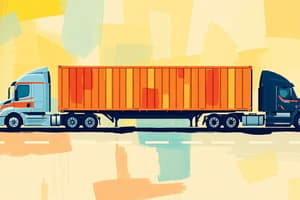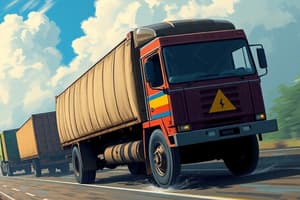Podcast
Questions and Answers
What is the approximate annual growth rate (CAGR) of India's logistics sector?
What is the approximate annual growth rate (CAGR) of India's logistics sector?
- 10.5% (correct)
- 8.5%
- 14.5%
- 12.5%
What percentage of its GDP does India spend on logistics costs?
What percentage of its GDP does India spend on logistics costs?
- 12%
- 10%
- 14% (correct)
- 16%
How many people does the logistics sector employ in India?
How many people does the logistics sector employ in India?
- 20 million
- 25 million
- 15 million
- 22 million (correct)
What is the estimated size of the logistics sector in India?
What is the estimated size of the logistics sector in India?
What is the aspirational logistics cost percentage of GDP for developed countries?
What is the aspirational logistics cost percentage of GDP for developed countries?
Which type of supply chain networks is not explicitly mentioned?
Which type of supply chain networks is not explicitly mentioned?
What role does CRM play within the described networks?
What role does CRM play within the described networks?
Which of the following options corresponds to a supply chain network's attribute?
Which of the following options corresponds to a supply chain network's attribute?
Which numbered label does not appear in the described diagram?
Which numbered label does not appear in the described diagram?
What is the purpose of the Multi-Nodel option as presented?
What is the purpose of the Multi-Nodel option as presented?
Which of these services is identified under the cost section?
Which of these services is identified under the cost section?
Which option reflects the presenter’s name listed in the content?
Which option reflects the presenter’s name listed in the content?
What is likely the highest possible serviceability score indicated?
What is likely the highest possible serviceability score indicated?
Flashcards
Supply Chain Networks
Supply Chain Networks
Different types of networks used to manage the flow of goods and services throughout a supply chain.
Direct Supply
Direct Supply
A type of supply chain network where goods or services are supplied directly to the customer or end user, bypassing intermediaries.
Serviceability
Serviceability
The ease and effectiveness with which a product or service can be maintained or repaired.
Multi Model
Multi Model
Signup and view all the flashcards
Multi-Node
Multi-Node
Signup and view all the flashcards
Indian Logistics Sector Size
Indian Logistics Sector Size
Signup and view all the flashcards
Indian Logistics Employment
Indian Logistics Employment
Signup and view all the flashcards
India's Logistics Cost
India's Logistics Cost
Signup and view all the flashcards
Developed Country Logistics Cost
Developed Country Logistics Cost
Signup and view all the flashcards
Supply Chain Network
Supply Chain Network
Signup and view all the flashcards
Logistics Modes Comparison
Logistics Modes Comparison
Signup and view all the flashcards
Study Notes
Logistics Sector in India
- India is one of the largest logistics sectors globally, estimated at $215 billion, with a growth rate of 10.5%
- The sector employs 22 million people (per Ministry of Commerce and Industry report)
- Logistics costs in India are estimated at 14% of the GDP, similar to other developing countries. Developed countries aim for 6-7%
- Transportation, warehousing, inventory, and order processing/administration costs make up the logistics cost of the Indian supply chain
Percentage Breakdown of Logistics Costs
- Transportation: 40% of total logistics costs, equal to 6% of Indian GDP
- Warehousing: 26% of total logistics costs, equal to 4% of Indian GDP
- Inventory: 24% of total logistics costs, equal to 3% of Indian GDP
- Order processing/administration: 10% of total logistics costs, equal to 1% of Indian GDP
Supply Chain Community
- The supply chain involves raw material supply, manufacturer, distributors, wholesalers, retailers, and end-users
Comparison of Logistics Modes
- Truck: Cost-effective for short distances, quick delivery, capacity limited by size/weight, extensive market reach, typically reliable but susceptible to traffic/weather. Low fuel efficiency
- Rail: Cost-effective for large volumes/long distances, comparable speed to truck, high carrying capacity, reaches major markets coast-to-coast, high visibility via GPS, and environmentally friendly.
- Water: One the least expensive modes, slow transit time, extensive coverage, but dependent on navigable waterways, and can be less reliable and harder to track.. Environmentally responsible.
- Air: Fastest mode for long distances, but highest cost, low carrying capacity, and susceptible to weather delays. Not very cost-effective.
Velotrade
- Velotrade outlines different terms of delivery conditions, highlighting the obligations and risk transfers between seller and buyer. Specific terms, like EXW, FCA, FAS, FOB, CFR, CIF, CPT, CIP, DPU, DAP, and DDP, are defined
Bird's Eye View of the Supply Chain Network
- The diagram illustrates a comprehensive network in which raw materials move from suppliers to manufacturers, with manufacturing and transportation costs illustrated. Warehouses and distribution centers play a crucial role, and these are connected to customers. Inventory costs are also noted.
Geographical Spread of Inland Logistics Network
- The network is strategically positioned near mines and ports, with customer service levels aiming for 2-day delivery across India.
Logistics FG Material Movements and Flow
- This section details the flow of finished goods materials within Tata Steel's logistics network. Transportation stages are shown.
Strategic Supply Chain Network Design Framework
- This conceptual framework details the three levels of operations, tactical, and strategic supply chain design
Cost vs Serviceability
- A graph illustrates the inverse correlation between Cost and Service. At low costs, serviceability is low, and at high costs serviceability increases, showing an inverse correlation.
Type of Supply Chain Networks
- This section discusses different supply chain types, including direct supply, cross-docking, milk run, and hub & spoke models, giving an overview of each model.
Physical Distribution & Satellite Unit
- A map highlighting various distribution locations (stockyards) in different zones (North, West, East, and South) is displayed
Types of Supply Chains
- Different types of supply chains are summarized: lean, agile, green, closed-loop, sustainable, and risk supply chains
Supply Chain Matrix
- A matrix model displays supply chain types for customer characteristics (predictable/unpredictable) and delivery time (long/short) and service attributes and efficiency attributes.
Stages of Logistics
- The infographic presents a 5PL (5th Party Logistics) outline for logistics management, detailing each stage from 1PL to 5PL
Studying That Suits You
Use AI to generate personalized quizzes and flashcards to suit your learning preferences.




